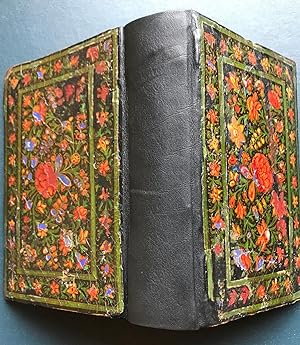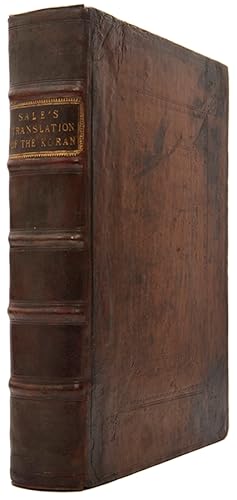Qur an or Quran or Kuran or Koran or Coran or Al Qur an (Over 11,000 results)
Product Type
- All Product Types
- Books (11,753)
- Magazines & Periodicals (34)
- Comics (4)
- Sheet Music
- Art, Prints & Posters (13)
- Photographs (1)
- Maps
-
Manuscripts &
Paper Collectibles (59)
Condition
Binding
Collectible Attributes
- First Edition (481)
- Signed (38)
- Dust Jacket (401)
- Seller-Supplied Images
- Not Printed On Demand (8,526)
Free Shipping
Seller Location
Seller Rating
-
Takhlis al-Bayan fi Majazat al-Qur'an, or 'Mujazat al-Radi', copied in the hand of the author, second volume only,
Published by Bayid Persia Baghdad dated 13 Shawwal 401 AH AD, 1010
Book
Single volume, second volume only of the text, decorated manuscript in Arabic, complete in alternating quires of 8 and 12 leaves with a bifolium at the end to complete the text, 162 leaves (plus one contemporary and 3 later endleaves), 218 by 118 mm; single column of 11-12 lines in sepia naskh hand of the author al-Sharif al-Radi himself, title on recto of first leaf, colophon at end of text in same hand, on distinctively Persian dark-cream paper, most leaves with mould markings (of 7-8 laid reed lines per centimetre, and with no chain lines apparent), final free endpaper with numerous ownership inscriptions (pre-fourteenth century), occasional marginal commentary (also pre-fourteenth century), some early damp-staining and mottling to leaves to entirety of volume affecting upper and outer corners, a few repairs to preliminary leaves including a closed tear to first leaf, strip of modern paper pasted along length of pastedown (probably from modern description once pasted there and subsequently removed), later endpapers and doublures inserted; fourteenth-century leather boards, stamped in blind and ruled with geometric patterns, skilfully rebacked, resewn and edges repaired, very presentable and attractive condition. islam24 07 Al-Sharif al-Radi (970-1015 AD) was a celebrated poet and scholar from Baghdad, whose was a direct descendent of Imam Ali, the cousin and son-in law of Prophet Muhammad. His father Abu Ahmad Hussayn was the Naqib of Iraq (a government position with responsibilities for the descendants of Prophet Muhammad) and chief Hajjaj for the region (overseeing pilgrimage to Ka'aba). He is buried in the Holy Shrine of Imam al-Husayn in Karbala. Al-Radi was a literary figure with extensive Islamic fiqh and tafsir expertise, who established the renowned Dar al'ilm (school of knowledge) in Baghdad during his lifetime. This school became a leading educational centre during his lifetime, and nurtured an entire generation of influential scholars, most notably al-Shaikh al-Tusi (995-1067 AD). As an author, Al-Radi is best known for his collection of commentaries on Imam Ali, entitled Nahj al-Balagha (peak of eloquence), which is commonly considered a masterpiece of Shi'ite literature and has remained popular with Shi'ite Muslims for a millennium. The present manuscript contains a lesser known and much rarer work entitled Takhlis al-Bayan fi Majazat al-Qur'an (roughly translating to 'summary of statements in the Qur'an'). It is a literary text focusing on the figurative and metaphorical meanings of phrases in the Qur'an, and is the first independent work of its kind to examine Qur'anic text through a literary perspective. The details given in the colophon of this codex are solidly supported by both a C14 test (by CIRAM -Science for Art Cultural Heritage of Martillac, France and New York, their report reference 0415-OA-98R-4 carried out in 2015, with them extracting the sample of paper from the book themselves: strip of paper from blank lower edge of fol. 10), as well as a report on the antiquity of the paper stock by Helen Loveday. The C14 analysis establishes a date of 986-1048 AD with a probability of 79.1%, and the paper stock is characteristically Persian and of the twelfth century or before (the extreme rarity of comparative eleventh-century manuscripts from this region forcing the dating parameters to be set as 'twelfth-century or before').
-
A large, early Ottoman or Pre-Ottoman (probably Qaramanid) Qur'an.
Published by Turkey, ca. 1500 / 15th-16th century CE., 1500
Seller: Antiquariat INLIBRIS Gilhofer Nfg. GmbH, Vienna, A, Austria
Folio (260 x 350 mm). Arabic manuscript on polished oriental paper. 520 ff. 9 lines of bold black Muhaqqaq-like script within gilt and blue-ruled borders. Surah headings in gilt thuluth script within gilt borders.Double-page opening bifolio with elaborate lapislazuli and gilt decorated borders,similar headpiece to verso of second leaf. Verses in clouds against a pink ground, gold verse markers pointed by blue and red dots, al-tajwid in red ink with occasional marginal notes in Turkish. Bound in slightly later full smooth auburn leather over wooden boards with prettily gilt fore-edge flap; a succession of gilt borders to both covers; central compartments decorated with a mesh of lozenges enclosing minute gilt flower-bud punches in the semé style. An early, very prettily illuminated Ottoman or Pre-Ottoman Qur'an in quite massive dimensions, measuring ca. 35 by 25 centimetres. Uncommonly, this manuscript contains an interlinear translation of the original Arabic text into Ottoman Turkish. - Some waterstaining throughout. Various edge flaws with occasional slight loss and old remarginings, more extensive near beginning and end. The colophon shows an illegible date, probably a later addition. Provenance: European private collection.
-
Miniature Qur an.
Seller: Sokol Books Ltd. ABA ILAB, London, United Kingdom
Manuscript / Paper Collectible
Hardcover. Condition: Very Good. FINE MINIATURE MS QUR AN Manuscript on paper, Herat, Muharram AH 963 / November 1555. Octagonal, 42 x 40mm. 427 paper unnumbered ll., 14 lines of naskh microcalligraphy per page, all leaves within circular ink ruling, heightened in blue and gold, circular verse markers in gold, sura titles in gold thuluth. First verso (sura Al-Fātiḥa) and second recto (beginning of sura Al-Baqarah) with 6 naskh lines of microcalligraphy within handsome sunburst illumination in blue, gold, red and green, last verso with floral decoration in gold. Tiny loss at blank foot of second leaf, couple of very minor tears to blank margins. A fine copy in contemporary dark green goatskin, triple gilt ruled, floral decoration to covers, eps in dyed green paper with plant motifs heightened in gold, a.e.g., rear joint starting and just cracked, but firm. Preserved in later octagonal silver box with carved Mushaf Sharif ( Holy Qur an ) in Arabic script. An exquisite octagonal miniature ms Qur an on fine paper, in naskh and thuluth microcalligraphy, dated November 1555 (Muharram al-haram, AH 963). A major centre for ms production in the previous century, by the mid-C16, under the Safavids, Herat still boasted a number of exceptional calligraphers, influenced by the fine C15 Timurid style. The colophon states the place and date of production, and is signed by the scribe, the last part of his name being al-Qari . The great hafiz (memoriser of the Qur an) and calligrapher Ali al-Qari (d.1605) was from Herat. Miniature ms Qur ans were used for personal devotion and protection, even as late as the C19. In the Ottoman Turkish world, octagonal miniature Qur ans ( sancak Qur ans ), functioning as amulets, encased in a box or fabric pouch, were tied to a military standard and carried to battle. This custom spread as far as India and Persia, where talismanic miniature Qur ans were also be tied to arm- or wristbands or carried in one s pocket, and generally close to the body. The present ms is indeed preserved in a (probably later) silver box with two holes to accommodate thread. The desire to bind textual amulets to the body and to keep Qur anic or other devotional texts close to the self is a materialization of a potent hadith (saying) attributed to Muhammad. [ ] The physical intimacy of the object worn near or against the owner s body symbolizes the intimacy between self and God available through the vehicle that is text (Gruber, pp.95, 103). Miniature mss, and Qur ans in particular, also allowed scribes to show off their outstanding skills, by writing dust-like ( ghubar ) calligraphy, in which, as here, alif , the tallest letter, is no taller than 1mm. However, in miniature Qur an mss, no matter how tiny the script, readability is never compromised , even though their owners were not required to actively read the text in order to benefit from its talismanic qualities; indeed, the reduction in scale served to further concentrate or distil its power (Ekhtiar, p.98). Provenance: The ownership of this ms is recorded in the oral history of the family of Abdulaziz (d.1876), 32nd Sultan of the Ottoman Empire, of the House of Osman, 96th Caliph, and the first ever Ottoman emperor to visit Western Europe. He was interested in literature and classical music; after being deposed in 1876, he died in mysterious circumstances. His daughter, Esma (d.1899), inherited the ms; it later passed to her second son, Huseyin Hayreddine Beyefendi (d.1956), who briefly lived in Cairo, and died in Istanbul. He bequeathed the ms to his brother Saadeddine Mohamed Beyefendi (d.1976). After his death in Beirut, Lebanon, the ms passed to his son, Saadeddine Mohamed Bey Osmansoy. S. de Laugier, Manuscrits d'Afghanistan (1964); M.D. Ekhtiar, How to Read Islamic Calligraphy (2018); H. Coffey, Islamic Miniature Books in the Lilly Library , in The Islamic Manuscript Tradition, ed. C. Gruber (2010), pp.79-115; S. Blair, Islamic Calligraphy (2005); C. Baker, Qur an Manuscripts (2007).
-
Safavid Qur'an.
Published by Shiraz, [22 Feb. 1616 CE =] 4 Safar 1025 H., 1616
Seller: Antiquariat INLIBRIS Gilhofer Nfg. GmbH, Vienna, A, Austria
Signed
12mo (86 x 147 mm). 418 ff. Arabic manuscript on paper. Black nasqkh script ruled in gilt, black, and blue. With 6 leaves fully illuminated in geometric and floral designs, an ornate illuminated 'unwan, and illuminated medallions in the margins. Qur'an followed by prayers in thuluth script on an illuminated double page. Early 20th century floral enameled boards with red morocco spine. An absolutely exquisite Safavid Qur'an decorated with six full pages of glittering, minutely detailed illumination with twisting floral borders and medallions in azurite or lapis lazuli. Following throughout the text are an elaborate 'unwan and marginal illuminated medallions and illuminated titles in white ruqa', and the juz' and name of the surah in red nasta'liq in the upper corner of each page. Placed at the end of the Qur'an is the Falnamah-i Qur'an ("book of omens"), consisting of a list of short interpretations associated with a letter of the Arabic alphabet: one opens the Qur'an to a page at random and reads the first letter on the page, then refers to the Falnamah to learn the meaning. - At the end of the text, the colophon is signed "Here ends this Qur'an [.] by the hand of [.] Mu'in al-Din who resides at the holy tomb of the Shaykh, Muslih al-Din Sa'di (Divine Mercy be upon him), the 4th day of the month of Safar of the year 1025", placing the scribe in early 17th century Shiraz. - Upper top corner lightly rubbed; a few traces of very subtle paper repairs. Remarkably well preserved. - The lacquered binding was commissioned by Mir Muhammad Khan, per an inscription dated 1321 H (1903/04 CE). In 1940 the manuscript appeared in the New York exhibition of Persian Art, and in addition bears the label of the collection of Armenian-American archeologist Hagop Kevorkian (1872-1962).
-
Manuscript Qur'an commentary.
Published by Sultanate of Delhi, [ca. 1490 CE, or 15th century]., 1490
Seller: Antiquariat INLIBRIS Gilhofer Nfg. GmbH, Vienna, A, Austria
Folio (244 x 345 mm). Persian manuscript, Bihari script on paper. 287 (instead of 292) ff., foliated 364-655 (lacking 550-551 and 622-624). Surah headings in gilt and colours, verse divisions marked by gold and black ink rosettes, numerous circular and tear-shaped markers in the margins, elaborately ornamented in gold and colours. Bound in modern oriental-style full leather with fore-edge flap and recessed cover decorations. Part four of a pre-Mughal Qur'an commentary, treating the text from Surah XXI, Al-Anbya (The Prophets) to Surah LXXV, Al-Qiyamah (The Resurrection). - Lacks five leaves according to the foliation; some dampstaining; several edge flaws (more severe near the end of the volume), often remargined. Traces of dust in the gutter throughout. In all a fine example of an early Qur'anic manuscript. - Provenance: 1950s private ownership stamp of the "Mohd. Halim Salimi Library", Kandahar, Afghanistan, on fol. 490v. Mohammed Halim Salimi of Kandahar worked in an administrative capacity for the USA's International Cooperation Administration (ICA) Mission to Afghanistan in 1959. In 1960 Salimi applied to the ICA for reimbursement of a lost sum of $123.88; the application was refused on the grounds that Salimi was not in fact an ICA employee but was sub-contracted by the agent Herman Klee (see report B-144148-O.M., 1 Nov 1960). Acquired from Hampel Auctions, Munich. - Cf. S. A. Blair, Islamic Calligraphy (Edinburgh 2006), pp. 386-390; Qur an, exhibition catalogue (Istanbul 2010), pp. 350f., no. 92.
-
Rare Kashmiri Teaching Qur'an, in a signed Indian binding.
Published by Kashmir North India circa, 1800
Book Signed
Single volume, illuminated manuscript on polished paper, in Arabic with interlinear translations to Farsi, extensive annotations to margins throughout in Farsi, complete, 548 leaves plus a later free endpaper at the back, 305 x 200 mm; single column, 11 lines black naskh script in Arabic, with interlinear 11 lines red nastaliq with Farsi translation, surah headings in red. leaves framed within double-ruling in red, interlinear colouring of cloud-like shapes around text in gilt throughout the volume, opening and final double-pages with gilt and polychrome decorations to margins extending outwards from the text block, ornamental designs to margins marking important sections of the text, these often in blue and gilt, many annotations throughout in a contemporary nastaliq script containing qur'anic commentary, many of these upside-down, preliminary and penultimate leaves with chips t outer edges (with slight loss), a few later repairs; housed in a contemporary decorated leather binding signed by the binder 'Umul' Fakhr al-Din', with flap, red leather with overlaid corner-pieces and central medallions in gilt stamped arabesque shapes, rebacked in modern red calf, silk page tabs marking important divisions of the text, a little rubbed at extremities. islam24 39 Rare example of a north Indian teaching Qur'an in a contemporary signed binding. In most cases, teaching Qur'ans are plain in their appearance because they are functional 'working' examples of the text for daily use. The present example, although provincial, has been illuminated in gilt and is of a higher quality than one would expect from a teaching Qur'an. The calligraphy is elegant and there is interlinear translation to Farsi, in a similarly attractive nasta'liq script with every single line of the Qur'an outlined in gold. There are wide margins throughout the volume, as often found in teaching Qur'ans, with contemporary annotations (in Farsi) providing commentaries and notes about various sections of the holy text. Many of these are upside-down and indicate that it is likely that the student would have recited from one side of the codex and the teacher would have faced them and read their notes from a reverse viewpoint. The level of gilding indicates that this volume was probably copied for the child/children of an important courtly figure. Furthermore the format of the annotations also suggests one-to-one private tuition instead of a teacher using the Qur'an for a wider audience (within a mosque or madrasa setting). The binding is also notable because some of the overlaid cartouches to the upper and lower boards are signed 'Umul' Fakhr al-Din', making this a rare example of a signed Indian binding. The style of the tooling and craftsmanship is most comparable to those of Persian Safavid leather bindings (particularly Haldane's examples 108 and 109, Islamic Bookbindings, London 1983), although the execution is provincial, it is an unusual example of an Indian binder attempting to emulate a Persian design.
-
Kashmiri Qur'an manuscript.
Published by Kashmir, ca. 1800 CE., 1800
Seller: Antiquariat INLIBRIS Gilhofer Nfg. GmbH, Vienna, A, Austria
Folio (205 x 312 mm). Arabic manuscript on paper. 53 ff., 33 lines to the page written in minute ghubar script in black ink, verse separated by a gold roundel, surah heading in red thuluth on gold background, margins illuminated with gilt discs or lozenges inscribed in red and enclosed within ornamental borders dotted in blue; fols. 1b-2a with a double-page illuminated frontispiece, lavishly coloured and gilt. Contemporary blindstamped and gilt black leather binding; spine rebacked. Marbled pastedowns. A fine, complete Qur'an manuscript, written in meticulous ghubar script and with pretty illumination, originating from the Kashmir region in the late 18th century. The characteristic calligraphy is known as "ghubar", or "dust script", for the minuscule size of its rounded letter forms. Created around the 10th century, it was first used for information and commands conveyed by carrier pigeon. Even the present, more generous form fits the entire Holy Qur'an into a slim folio of only fifty-odd pages. - Edges occasionally very slightly chipped but generally very fine. Binding well preserved with modern spine. The central compartment of the pretty binding shows a Qur'anic verse (Surah 56, verse 79: "to be touched only by the purified") stamped in blind three times on both covers. - Provenance: Parisian private collection (2nd half of the 20th century).
-
An early Qur'an leaf in Kufic script, containing the text for surah Taha, verse 34 (part) - 39 (part).
Published by Abbasid Near East or North Africa 9th century AD
Art / Print / Poster
Single folio, fine decorated manuscript on parchment, in Arabic, containing the text for surah Taha (part of verse 34 to beginning of 39), 277 x 290 mm; single column, 7 lines bold scribal stylised kufic script in dark sepia, vocalisation in the form of red dots and verses marked with green dots, some very light age-toning to parchment else very bright and attractive condition; framed and glazed. islam24 01 A strikingly rare example of scribal freehand from the Abbasid period that is known for producing Qur'ans in a highly regular and formal manner. Scribes from this period are very likely to have copied the Qur'an from memory and this folio demonstrates a moment in time when the scribe gently ventured into a broad free-hand during the copying process onto vellum which evidently lacked any preparatory rulings, resulting in a strong and beautiful kufic calligraphy that stands apart from all the other examples of it's kind. The style of script is most comparable to the Déroche classification of the 'D' group, being the most varied group of the early Abbasid scripts, which is distinctive for it's use of thick lines and vertical stroked that are always perpendicular to the base. This leaf is likely to have been part of the same parent manuscript as the famous MS. 322 in the Institute of Oriental Studies Lenningrad, according to Déroche (see The Abbasid Tradition, London, 1992, p. 126, no. 69 for more information).
-
Illuminated miniature octagonal Qur'an.
Published by [Persia, ca. 1890 / 19th century CE]., 1890
Seller: Antiquariat INLIBRIS Gilhofer Nfg. GmbH, Vienna, A, Austria
314 ff., octagonal (75 x 78 mm). Arabic manuscript in minute gilt naskh script on blue paper, 14 lines within octagonal gilt borders, surah headings in red ink on gilt, gold discs between verses. Contemporary Persian lacquer binding with floral decoration to covers (inside and outside). Opening double page, beginning and final double page richly illuminated with gilt and polychrome borders. Stored within a contemporary custom silver case with lockable clasp. A beautifully illuminated octagonal miniature Qur'an, uncommonly written on dark indigo blue paper. The meticulously hand-painted floral lacquer binding is characteristic of the 19th century Persian style. Stored in a custom-fitted sterling silver case, bottom punched "Silver" and "925", finely wrought with ornamental tendril designs. In excellent condition.
-
Fine Ottoman Qur'an, signed by Mustafa known as Husari, student of Yusuf known as Khwaja Sarayi.
Published by Ottoman Turkey dated AH 1782-83 AD, 1196
Book
Single volume, illuminated manuscript on paper, in Arabic, 295 leaves, 167 x 115 mm; single column, 15 lines accomplished black naskh, diacritics in black and some vocalisation in red, surah headings in white against gilt banners with polychrome decorations and ornamentations, opening two pages with richly illuminated and decorated polychrome and gilt borders, executed in the traditional Ottoman style with central textblocks and wide decorated margins extending outwards, catch-words throughout, gilt and decorated marginal devices marking important sections of the text, front and free endpapers of pink-stained gilt speckled paper with illustration of a flower, some light water-staining, a few scattered smudges to ink; housed in early nineteenth-century full leather with flap. covers and flap with borders ruled in blind, doubleurs of decorated paper of an abstract swirling gilt design, very lightly rubbed at extremities, overall a handsome volume. misc23 An attractive Ottoman Qur'an copied during the reign of Sultan Abdul Hamid I (r. 1774-1789). The concise calligraphy and elegant illumination throughout the volume indicate courtly patronage, likely commissioned by or for a high-ranking member of the Ottoman courts in 1196 of the Hijri calendar.
-
A splendid illuminated Qur'an manuscript.
Published by Iran, [1783 CE] = 1204 H., 1783
Seller: Antiquariat INLIBRIS Gilhofer Nfg. GmbH, Vienna, A, Austria
8vo (148 x 90 mm). Illuminated Arabic manuscript on paper, 243 leaves plus 2 fly-leaves, complete. 19 lines per page, written in a neat Naskhi script in black ink with diacritics in red, margins ruled in gold and colours. Gold discs or florets between verses, sura headings written in white within gilt cartouches flanked by panels with alternating floral motifs in gold and various colours. Brown morocco with flap and giltstamped borders and central ornaments. Splendid pocket-size Qur'an. Marginal section markers in white naskh on gold ground within polychrome flower blossom, opening double-page frontispiece richly illuminated in lapis lazuli blue, green, red, pink, and gold, the text within cloud bands in gold. - Hinge tender between the first two pages, some light marginal fingering, otherwise in perfect condition. From the library of the scientists and collectors Crawford Fairbanks Failey (1900-81) and Gertrude Van Wagenen (1893-1978), who performed research at Yale and Johns Hopkins in the fields of medical chemistry and biology.
-
243 ll. plus 2 end-leaves.Splendid pocket-size Qur an. Marginal section markers in white naskh script on a gold ground within a polychrome flower blossom, opening double-page frontispiece richly illuminated in lapis lazuli blue, green, red, pink and gold, the text within cloud bands in gold.Hinge tender between the first two leaves, some light marginal fingering, otherwise in fine condition. From the library of the scientists and collectors Crawford Fairbanks Failey (1900-81) and Gertrude Van Wagenen (1893-1978), who performed research at Yale and Johns Hopkins in the fields of medical chemistry and biology.
-
Single volume, illuminated manuscript on polished paper, in Arabic, 198 leaves, complete, 105 by 65 mm; single column, 21 lines elegant black naskh per page, surah headings in ref thuluth against gilt banners throughout, opening two leaves with elaborately decorated gilt head-pieces and further gilt polychrome additions to the outer borders, fihrist at the front of the Qur'an and closing prayers at the end copied in blue and red within arabesque shapes set against decorative floral backgrounds, catch-words, a few small stains and light finger-soiling, overall very bright and attractive condition; contemporary lacquered boards, framed within gilt borders (later gilding), edges painted with floral motifs in gilt, rebacked, a handsome copy. Very attractive pocket-sized Qur'an copied in a regular scribal hand and dated 1800 AH. The Qajar dynasty began in 1797 and saw a flourish in artistic endeavours under the patronage of Fath' Ali Shah Qajar. The present manuscript is a very early representative of this new style of manuscript art illumination from an era that became one of the most iconic in Persian art history.
-
Prayers and excerpts from the Qur an copied by Omar ibn Hassan.
Published by Sudan, 19th century.
Seller: Antiquariat INLIBRIS Gilhofer Nfg. GmbH, Vienna, A, Austria
4to (215 x 260 mm). 371 ff., loose as intended, plus an additional 16 ff. of a smaller (145 x 178 mm) manuscript, also loose. Arabic manuscript on paper. Brown Sudani version of maghribi script with important words and phrases picked out in red. Never bound, comprising loose leaves between two hide covers, wrapped in hide case with twine tie. In protective custom stiff cardstock folding case. This manuscript, laid loosely in goatskin, comprises a selection of prayers and excerpts of the Qur'an in bold maghribi script, copied by a man named 'Omar ibn Hassan in Sudan. Laid in is a curatorial note written on the reverse of a printed invitation inscribed to Ruskin Butterfield (1872-1935), a curator of the Hastings Museum and allegedly involved in the evaluation of the nearby Piltdown Man Forgery Case, perhaps the most famous paleontological hoax in history. The note on his card reads: "Copy of Koran - Given to the Hastings Museum by the late H. E. Dresser, the eminent ornithologist. Said to have been taken from a dead soldier at the Battle of Omdurman". A later note in pencil adds, "Written by Cyril Davenport, curator of bindings, British Museum". - Assuming veracity, one may trace this manuscript from its scribe 'Omar ibn Hassan to the 1898 battle of Omduram in Sudan, today a district of Khartoum. Fought against the British-Egyptian expeditionary force by Mahdist troops, the battle was catastrophic for the Mahdists and the future of a Sudan independent from British colonial control. Amongst those present on the British side were a young Winston Churchill and Douglas Haig (1861-1928), British commander at the WWI Battle of the Somme and at Ypres. - There is no record, however, of the British businessman and internationally acclaimed ornithologist Henry Eeles Dresser (1838-1915) ever being in Africa, much less present at the British invasion of Sudan, despite his other extensive travels in North America and Europe. Regardless, from his hands it was donated to the Hastings Museum in the quiet Sussex town by the same name, possibly in 1907, a date which appears next to the library stamp which reads "Brassey Institute - Hastings Museum". The Brassey Institute was where the museum resided prior to 1923, and was named for the Brassey family, the most prominent member and collector of which was Lady Annie Brassey (1839-87), who did in fact travel to Egypt and possibly Sudan, but died eleven years before the Battle of Omdurman. - The final name tied to the manuscript, Cyril Davenport (1848-1941), worked as a bookbinding specialist for the British Museum from 1868 to 1913; he may have had some interest in the binding style of the manuscript, which while an established tradition in the Horn of Africa and surrounding areas, is quite distinctive from other Arabic manuscript traditions and beautifully represented here. Another, smaller manuscript is laid in, also loose, with similar style and content. - Light edgewear and toning to some leaves, which are not entirely in order. Generally bright and clean. - Provenance: Based on laid-in note, (1) Unnamed Sudanese soldier. (2) Collection of Henry Eeles Dresser (1838-1915). (3) The Brassey Institute and Hastings Museum, Hastings, UK. (4) Bloomsbury Auctions, 2009.
-
An illuminated Qur'an, Juz' XII.
Published by China, ca. 1800 CE., 1800
Seller: Antiquariat INLIBRIS Gilhofer Nfg. GmbH, Vienna, A, Austria
Small folio (230 x 295 mm). Arabic manuscript on cream-coloured paper. 58 ff. (plus 2 flyleaves), 5 lines per extensum, written in crisp Sini script in black ink. Text within red double rules, verses separated by gilt roundels, surah heading in gold outlined in red. Opening bifolio with brightly coloured and gilt quasi-geometric illumination, final bifolio with gold and polychrome Central Asian floral and tendril motifs in the borders. Contemporary blind-tooled brown leather binding with fore-edge flap. Indigo blue cotton endpapers. Prettily illuminated Qur'an Juz' (one of thirty parts of varying lengths into which the Qur'an is divided) written in late 18th or early 19th century China. Arab presence in China dates back as far as the first Caliphate: the Prophet's companion Sa'd ibn Abi Waqqas is traditionally credited with introducing Islam to China as ambassador in 650. Indeed, many major cities in China, such as Xi'an (or Chang'an, as it was known during the height of the Silk Road) and Beijing boast a long and rich Muslim history. Qur'an sections written by Chinese Muslims show Chinese influence clearly in both the decoration and the script, which is derived from naskh. The section of the Qu'ran copied here is the twelfth Juz', which comprises surah 11 (Hud), aya 6, to surah 12 (Yusuf), aya 52, named after the prophets Hud and Joseph. - Fingerstaining to lower corner and margin. An attractively illuminated example of the Chinese Muslim manuscript tradition.
-
Calligraphic scroll containing excerpts from the Qur'an.
Published by Early Qajar Persia circa AD, 1800
Book
Single scroll formed of 8 membranes, illuminated manuscript in Arabic, containing excerpts from the Qur'an, complete, 4200 by 80 mm; text arranged in multiple columns and sections often forming geometric patterns or calligraphic compositions, in black ghubari script with important sections in red, opening of scroll with illuminated head-piece (darkened, a little chipped and early repair in sellotape), many sections outlined in gold, margins ruled in gold and blue throughout, a few small chips to outer edges of scroll, rarely affecting text, a few ink stains and smudges, seal stamps to foot of scroll, housed in mid-twentieth-century tin (?) tube with type-script label. islam24 28 An attractive calligraphic Qur'anic scroll containing excerpts from the Holy text in stylised forms forming geometric patterns and calligraphic compositions. The seal impression at the foot of the manuscript is dated 1217 AH (1802 AD), which firmly places the manuscript right at the beginning of the 19th century, circa 1800 AD, making it a very early example of Qajar manuscript production.
-
Collection of Qur'anic surah and commentaries, compiled by Ibn Tawus, including extracts on the teachings of Jafar Sadiq, copied by Muhammad Ibn Mirza.
Published by Qajar Persia possibly Tabriz early-19th century.
Seller: Robert Frew Ltd. ABA ILAB, London, United Kingdom
Book
Single volume, illuminated manuscript on polished paper, in Arabic, complete, 106 leaves. 8vo. (23 x 14.5 cm); single column, 11 lines black naskh, headings and important phrases in blue, gilt polychrome head-piece opening the text, gilt borders to opening two pages, interlinear colouring in gilt throughout, eaves with polychrome and gilt ruling, catch-words, Persian export stamps to first and final leaves, some of the gatherings becoming loose, a few ink smudges else clean internal condition; housed in a very attractive painted lacquered binding, covers with floral designs set in an oval shape set against a striking black background with borders of a similar design, all heightened in gilt. Upper cover slightly rubbed, extremities lightly bumped. Fine lacquered binding. An unusual prayerbook containing some Qur'anic sections alongside a number of dua compiled by Ibn Tawus and including religious tracts by Jafar Sadiq. Commissioned privately by Muhammad Ibn Mirza in the early nineteenth-century and present here in a fine hand-painted Qajar lacquered binding.
-
An illuminated Qur'an, Juz' X.
Published by China, [ca. 1790 - later 18th century CE]., 1790
Seller: Antiquariat INLIBRIS Gilhofer Nfg. GmbH, Vienna, A, Austria
8vo (200 x 288 mm). Arabic manuscript on paper. 50 ff. Script in bold black sini, 5 lines within red double rules, punctuation in red, gold rosette verse markers outlined in black, surah headers in gold, gold and polychrome marginal decoration, opening bifolium with red, blue and black and gold illuminated panels around three lines of text. Restored 18th century red leather with fore-edge flap, elaborately ruled and stamped in blind. Beautifully illuminated Qur'an Juz' (one of thirty parts of varying lengths into which the Qur'an is divided) written in 18th century China. Arab presence in China dates back as far as the first Caliphate: the Prophet's companion Sa'd ibn Abi Waqqas is traditionally credited with introducing Islam to China as ambassador in 650. Indeed, many major cities in China, such as Xi'an (or Chang'an, as it was known during the height of the Silk Road) and Beijing boast a long and rich Muslim history. Qur'an sections written by Chinese Muslims show Chinese influence clearly in both the decoration and the script, which is derived from naskh. The section of the Qu'ran copied here is the tenth Juz', which comprises surah 8, al-Anfal ("The Spoils") and surah 9, al-Tawbah ("The Repentance"). These two surahs form a set, and are best read as a pair. Both give an account of battles: al-Anfal describes the Battle of Badr, while al-Tawbah describes the Battle of Tabuk. - Covers fully rebacked, with some mild warping; some paper repair and reinforcement. Altogether a fine example of the Chinese Muslim manuscript tradition. Provenance: Private UK collection formed in the 1960s and 1970s.
-
Timurid manuscript Qur'an.
Published by [West Asia, ca. 1400 / 14-15th century CE]., 1400
Seller: Antiquariat INLIBRIS Gilhofer Nfg. GmbH, Vienna, A, Austria
8vo (174 x 128 mm). 302 ff. Arabic manuscript on paper, 15 lines in an elegant Naskh script ruled in gilt and blue, decorated with gold, blue, and red floral medallions throughout. First two pages illuminated with elaborate borders in royal blue, deep blue, gold, black and red. Contemporary red leather with floral device blindstamp, rebacked. A lovely and uncommonly early Qur'an written in an elegant hand, with a double-page illuminated 'unwan in shades of blue and gold with elaborate floral and geometric designs. Divisions in the text are marked with gilt floral medallions, and some headings are picked out in gilt. Dating to the late 15th or early 16th centuries, this Qur'an is likely from the late Timurid period, just prior to or during the transition from one great West Asian Muslim empire to the next, with the rise of the Mughals. - Spine replaced and covers fully rebacked, tidy paper repairs without loss to text; a nice early copy.
-
Manuscript Qur'an.
Published by Kashmir, 19th century CE.
Seller: Antiquariat INLIBRIS Gilhofer Nfg. GmbH, Vienna, A, Austria
8vo (150 x 226 mm). 258 ff. Arabic manuscript on paper. Black naskh script with cloudband gilt decoration throughout, section titles in white on gilt with floral borders, text ruled in gilt, red, blue, and outer floral border, marginal illuminated floral medallions. With eight double-page 'unwan title borders, bound at the front, throughout, and at the end of the manuscript. Contemporary floral lacquer binding with hand-painted floral decorations. Elaborately decorated Qur'an, and a beautiful example of a 19th century lacquered binding: the gilt covers are decorated with flowers so carefully hand-painted that some species can be individually identified. The inside of each cover features cornflowers painted on a yellow field in a red and pink border. The text itself is no less lavishly decorated, with interlinear gilding (or "cloudband" gilt) throughout, gilt backgrounds for section titles, and marginal medallions picked out in colours and gilt, also painted in the floral theme. Interestingly, the manuscript boasts not one but eight double-page 'unwan borders, including one bound in at the end of the manuscript. All are elaborately decorated in gilt and colours. Overall, a lovely example of this period of Qur'an decoration. - Some chipping to gilt on covers and to spine, some marginal worming. Altogether in good condition.
-
[ LE CORAN ou KORAN en ARABE avec TRADUCTION en LATIN ] - REFUTATIO ALCORANI , IN QUA AD MAHUMETANICAE SUPERSTITIONIS RADICEM SECURIS APPONITUR ; & MAHUMETUS IPSE GLADIO SUO JUGULATUR [ TOME II de ALORANI TEXTUS UNIVERSUS ] - 1698 - EDITION ORIGINALE
Seller: LA FRANCE GALANTE, Saint MARTIN sur LAVEZON, France
Book
Couverture rigide. Condition: Très bon. Patavii [ PADOUE / PADOVA ] . Ex Typographia Seminarii . 1698 . EDITION ORIGINALE . Un grand volume in-folio , 23 x 32,5 cm , reliure postérieure , demi vélin à pieces de titre & de tomaison cuir . De 8 pages , 838 pages du CORAN en ARABE , avec en regard la traduction en LATIN . Les 11 pages d'INDEX qui MANQUENT ont probablement été reliées à la fin du tome I . Ce tome II forme un tout avec le CORAN en ENTIER . Il compte deux fois plus de pages que le tome I . UN OUVRAGE de 1698 PROCHE de l'ÈTAT de NEUF , sans aucune inscription , sans rousseur . RARISSIME dans cet etat de fraicheur .
-
Reflections on Mohammedism, and the conduct of Mohammed. Occasioned by a late learned translation and exposition of the Koran or Al Koran.
Published by London, J. Roberts, 1735., 1735
Seller: Antiquariat INLIBRIS Gilhofer Nfg. GmbH, Vienna, A, Austria
8vo. (2), 54 pp. (wanting half title). - (Bound with) II: Henley, John. The Lord, He is God: or, The Atheist Tormented, by Sure Prognosticks of Hell Fire [.]. London, J. Roberts, 1730. 29, (1) pp. - (Bound with) III: [Lewis, Thomas. The nature of hell, the reality of hell-fire, and the eternity of hell-torments, explain'd and vindicated. London, J. Hooke & T. Bickerton, 1720]. 38 pp., (2 pp. of ads), wanting 4 pp. of prelimns including the title. - (Bound with) IV: [Oakes, Abraham]. The doctrine of hell-torments distinctly and impartially discussed. London, J. Noon, 1738. 72 pp. - (Bound with) V: [Fludger, John]. The absolute and proper eternity of hell torments fully proved from scripture, from reason, and from the natural attributes of God. London, T. Gardner, 1739. (2), 36 pp. - (Bound with) VI: Phileleutherus Dubliniensis [i.e., Patrick Delany]. Reflections upon polygamy, and the encouragement given to that practice in the scriptures of the Old Testament. London, J. Roberts, 1737. (2), 188 pp. - (Bound with) VII: [Booth, George, Earl of Warrington]. Considerations upon the institution of marriage. With some thoughts concerning the force and obligation of the matrimonial contract. Wherein is considered, how far divorces may, or ought to be allowed. London, John Whiston, 1739. VI, 154 pp. - (Bound with) VIII: [Clarke, Alured]. An essay towards the character of her late majesty Caroline, queen-consort of Great Britain, &c. London, J. & P. Knapton, 1738. (2), 46 pp. - (Bound with) IX: [Hildrop, John]. A letter to a member of Parliament, containing a proposal for bringing in a bill to revise, amend or repeal certain obsolete statutes, commonly called the ten commandments. London, R. Minors, 1738. (2), 61, (1) pp. Contemporary full calf, gilt. Only edition; rare: an apology of Islam and its Prophet, influenced by the writings of Pococke and Reland, and published a year after George Sale's "Koran", the first English Quran to be translated directly from the Arabic. The anonymous author counts among those "interested in revising 'imposture' theories by recasting Mahomet in a positive, Greco-Roman republican mold - a wise 'Arabian legislator' [.]. [This work,] occasioned by Sale's translation of the Qur'an, suggests that Islam anticipates the Protestant Reformation: Mahomet 'laid the foundations of a general and thorough Reformation, Conversion, and Re-Union in ages to come'" (H. Garcia, Islam and the English Enlightenment, 1670-1840 [2011], p. 256). From the beginning the author cautions that "no disputes ought to be conducted with more temper and moderation than those about religion, but, unluckily, none have been managed with such warmth, bitterness, and inequality" (p. 1); he defends the Prophet against unjust accusations levelled against him by his Christian detractors and closes with the admonition that young British scholars of theology would do well "to apply themselves, among their other exercises, to the study of the oriental tongues, which, upon an impartial survey of the present state of religion, seems to claim much of their attention" (p. 53f.). - Bound with this are eight other English theological works (all first or only editions) concerned with hell-fire and heresies, several written with a decidedly free-thinking slant. Binding severely rubbed and bumped; hinges cracked. Variously browned throughout with occasional staining; contemporary handwritten table of contents on loose flyleaf; second flyleaf clipped with a handwritten title "A Vol. of scarce & curious Tracts" on verso; first title page has 19th century ownership stamp "R. Blackwell". - ESTC T91614. Chauvin XI, 680 (note).
-
An illuminated Qur'an, Juz' XXIX.
Published by China, [ca. 1780 - 18th century CE]., 1780
Seller: Antiquariat INLIBRIS Gilhofer Nfg. GmbH, Vienna, A, Austria
8vo (180 x 252 mm). Arabic manuscript on paper. 58 ff. Script in bold black sini, 5 lines within double red rules, punctuation in red, black outlined gold rosettes between verses, headers in gold text on red ground, opening bifolium with red, blue and black and gold illuminated panels around three lines of text. 18th century full red leather with fore-edge flap, elaborately ruled and stamped in blind. Handsomely illuminated Qur'an Juz (one of thirty parts of varying lengths into which the Qur'an is divided) written in 18th century China. - Arab presence in China dates back as far as the first Caliphate: the Prophet's companion Sa'd ibn Abi Waqqas is traditionally credited with introducing Islam to China as ambassador in 650. Indeed, many major cities in China, such as Xi'an (or Chang'an, as it was known during the height of the Silk Road) and Beijing, boast a long and rich Muslim history. Qur'an sections written by Chinese Muslims show Chinese influence clearly in both the decoration and the script, which is derived from naskh. Juz' 29, the penultimate Juz' of the Qu'ran shown here, begins with surah 67, al-Mulk (The Sovereignty), and closes with the fifty lines of surah 77, al-Mursalat (The Emissaries). - Binding rebacked and spine and endpapers professionally replaced; subtle paper repairs; some later pagination marks. Altogether a beautiful example of the Chinese Muslim manuscript tradition. Provenance: Private UK collection formed in the 1960s and 1970s.
-
Fine Indian Qur'an.
Published by Srirangapatna or Bangalore South India n.d. but early 19th century
Book
Single volume, decorated manuscript on polished light blue paper, in Arabic, complete, 335 x 230 mm; single column, 15 lines black cursive verging on naskh, surah headings and qur'anic divisions to margins in red, catch-words, nineteenth-century manuscript note relating to the provenance of the manuscript pasted to front free endpaper, additional folios of prayers at the end of the volume (copied in the same hand as the Qur'an), excellent condition internally; contemporary red morocco with flap, tooled and ruled with cream-coloured paper onlays to medallions, extremities lightly rubbed else a very good example. islam24 40 Rare south indian qur'an in a contemporary indian leather-tooled binding, present here in an excellent state of preservation. Seyyed Hussain was a Sergeant in the 4th Native Cavalry, British Regiment, and Munshi to the Duke of Wellington during the Fourth Anglo-Mysore War at Srirangapatna in 1799 before becoming the aide-de-camp to Sir John Malcolm. The attached letter relating to the provenance of the manuscript reads: 'The Koran in Arabic, from a very perfect copy in the library of Mahmoud Sufi (?) with marginal notes from two other collated (?) copies. Purchased from Seyyed Hussain (formerly munshee to the Duke of Wellington in Srirangapatna), Bangalore, 1844'.
-
Coran. Manuscrito islámico sobre papel con las dos primeras páginas (enfrentadas) bellamente decoradas en oro y color tipo mezquita.Totalmente manuscrito con 11 lineas por página.Con puntos rojos separando cada verso. Con numerosos comentarios en rojo en los márgenes. El principio del libro está escrito en árabe,pero después se intercala el persa entre el texto.
Published by (Ap.1830)., s.l., 1830
Seller: Llibreria Antiquària Els Gnoms, Sedó, Spain
487hh. no numeradas. Curioso y muy raro Coran de bolsillo procedente de algún lugar del ex Imperio Otomano. Perfecto estado.
-
Illuminated Qur'an manuscript.
Published by [Ottoman Empire], [1807 CE] = 1222 H., 1807
Seller: Antiquariat INLIBRIS Gilhofer Nfg. GmbH, Vienna, A, Austria
Signed
8vo (165 x 105 mm). Illuminated Arabic ms. on paper. 312 ff., 15 lines, Naskh script. Black ink on polished paper. Double-page 'unwan on first two pages shows elaborate gilt ornamentation; ornamental colophon. Borders in red, black and gold. Gold discs between verses, sura headings written in gold. Blindstamped and gilt calf. Signed by a copyist named Hafez 'Ahmad ibn Ahmad al-ma'ruf, "Ahmad the Hafez" (respect title bestowed on those who have proved to know the entire Quran by heart), son of the renowned Ahmad , as quoted (underlined) in the colophon: Kataba hada-l mushaf as-sarif adafu ibad- Allah al-Kabir al-Mutaal Hafez Ahmad, ibn Ahmad almaruf,ba-yawwab-e (?) halifa-zade Hamidu-llah Taala [.] (literally, he who wrote this noble Qur'an is a very foolish slave of God the Greatest, the Exalted, named Hafez Ahmad, son of the renowned Ahmad, servant (?) of Hamidu-llah Taala, offspring of the Caliph [ ] ), etc. - Binding partially restored, in good condition.
-
[The Koran.] The Alcoran of Mahomet. First English Edition. Printed in 1649.
Publication Date: 1649
Seller: Merchants Rare Books, Moab, UT, U.S.A.
First Edition
The Koran. Printed in 1649. First English Edition. Prior to this book the Koran had never before been translated into English. â Â"â Â"â Â" Full title: The Alcoran Of Mahomet, Translated Out Of Arabique Into French; By The Sieur Du Ryer, Lord Of Malezair, And Resident For The King Of France, At Alexandria. And Newly Englished, For The Satisfaction Of All That Desire To Look Into The Turkish Vanities. [The Koran]. By Du Ryer, Andre Considered an inferior translation. The later translation by Sale is held in higher regard. Still, this 1649 book is the first edition of the Koran ever translated into the English language. The spine is not original. The covers are original. Text is complete. This book measure approximately 7 inches tall. This is a small book. Quality rag paper is still supple, and this book can be read. LONDON, 1649. FIRST ENGLISH TRANSLATION. SMALL OCTAVO, CONTEMPORARY BOARDS (WITH SOME WEAR) WITH A NEW SPINE, NEW ENDPAPERS. THE BOOK WAS FIRST TRANSLATED OUT OF ARABIC INTO FRENCH BY THE SIEUR DU RYER. CONTAINS: A TRANSLATOR'S NOTE TO THE CHRISTIAN READER; THE FRENCH EPISTLE TO THE READER; A SUMMARY OF THE RELIGION OF THE TURKS; A NOTE TO MR. DU RYER; CONTENTS TABLES; THE ALCORAN (393 pp.); THE LIFE AND DEATH OF MAHOMET (pp 395-405); A NEEDFULL (SIC) CAVEAT OR ADMONITION.BY ALEXANDER ROSS (15pp.) VERY SCARCE. Printed on quality rag paper that is still fresh. The spine was rebacked circa 1900. The covers are original. This book is over 350 years old. â Â"â Â"â Â" Mahomet is Mohamed. Definitions of Mahomet: the Arab prophet who, according to Islam, was the last messenger of Allah (570-632) synonyms: Mahound, Mohammad, Mohammed, Muhammad. example of: prophet. someone who speaks by divine inspiration; someone who is an interpreter of the will of God. I'll take better pictures when I get a chance. This book will be well protected for shipping via Priority Mail. Your signature will be required for delivery. â  Spine rebacked. Covers are original.
-
Hardcover. Condition: Good. [16.8 x 10 cm], Arabic manuscript on smoothed paper. Modern calf binding, later added using boards of Qadjar lacquer of the early 19th century with flower illustrations (covers with damages and defects). Manuscript illuminated with three double ornamental pages, written in Naskhi script, the interlinear recitation instructions are in red. Ink here and there a little bit blurred, slightly soiled mainly at margins, fitted in a modern cloth box, no date, no signature, 19th century. The 'Unwan at the end of the manuscript is unusual, whereas double ornamental pages within certain suras, as can be found here, can be found more frequently. #34917.
-
The Koran, commonly called the Alcoran of Mohammed, translated from the original Arabic.
Published by London, 1734
Book First Edition
First edition in English translation, 4to, [6], iii-ix, [3], 187, [1], 508, [16] pp., title in red and black, folding engraved map of Arabia (trimmed) and plate & plan of Mecca, 3 engraved genealogical tables (2 folding),upper margins a little mottled and some browning, bookplates and ink inscription to front free endpaper and upper pastedown; contemporary panelled calf, a little rubbed, rebacked with spine in raised bands, morocco label lettered in gilt, covers scuffed and rubbed. George Sale (1697 1736) was a British Orientalist and lawyer. This first edition was published in 1734 and was the first edition of the Qur'an to have been translated into English directly from Arabic, becoming a landmark text in Qur'anic studies. Due to its vast popularity, remained in print well into the first half of the 20th century with over 120 editions available.
-
[An Attractive Indian Qur'an, in a contemporary lacquered binding.
Published by Kashmir ? circa AD, 1810
Book
Single volume, illuminated manuscript on paper, in Arabic, complete, 318 leaves plus two later free endpapers, 120 x 80 mm; single column, 14 lines scribal black naskh per page, surah headings in red throughout, first three leaves with interlinear translations to Farsi in red nasta'liq (interlinear spacing continues through the volume, remaining translation never completed), opening two leaves with elaborately decorated gilt and polychrome decorations, these comprising spiralling vines adorned with pink, red, blue and white flowers, leaves throughout double-ruled in gold and black, catch-words throughout, final two leaves with additional gilt polychrome decorations to borders, some small stains and ink smudges, overall attractive condition; hosed in contemporary Kashmiri papier-mâché lacquered boards, outer covers with floral decorations ruled in gilt, inner covers of gold spiralling vines against a striking black background, rubbed and skilfully rebacked. ASIANART22.


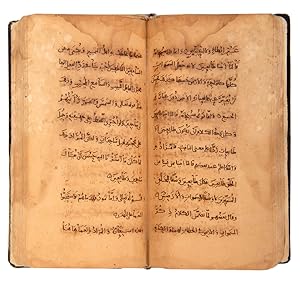
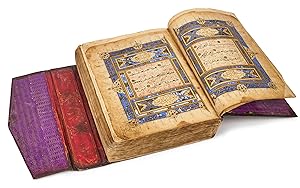
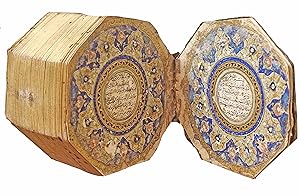
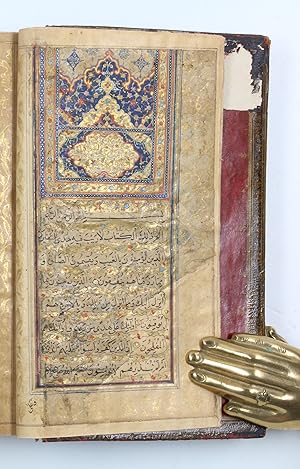
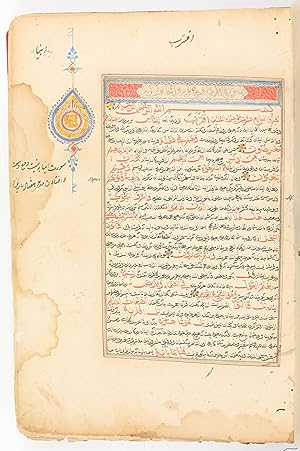
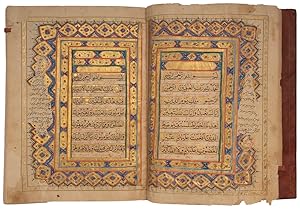
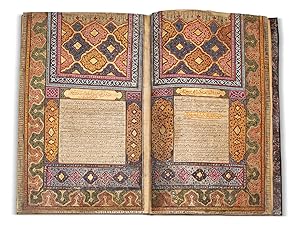
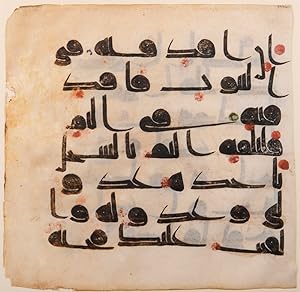
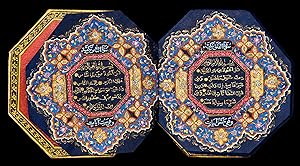
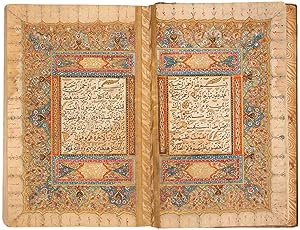
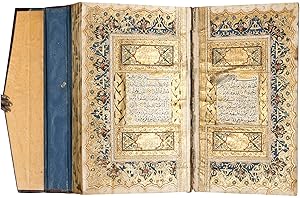
![Seller image for [A splendid illuminated Quran manuscript].Iran, AH 1204 [= 1783 AD]. 8vo (15 x 9 cm) Illuminated Arabic manuscript on paper, 19 lines per page, written in a neat naskh script in black ink with diacritics in red, margins ruled in gold and colours. Gold discs or florets between verses, sura headings written in white in gold cartouches flanked by panels with alternating floral motifs in gold and various colours. Brown morocco with a flap and gold-tooled borders and central ornaments. for sale by Antiquariaat FORUM BV](https://pictures.abebooks.com/inventory/md/md30708218560.jpg)

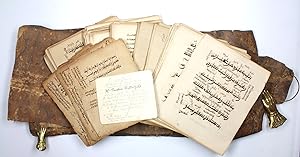
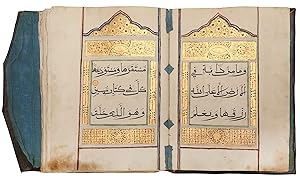

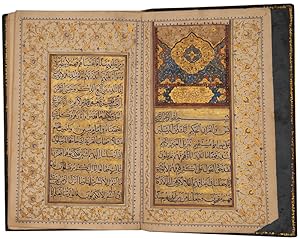

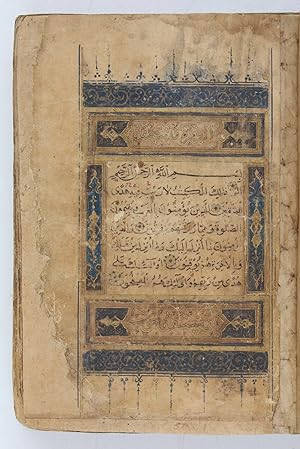
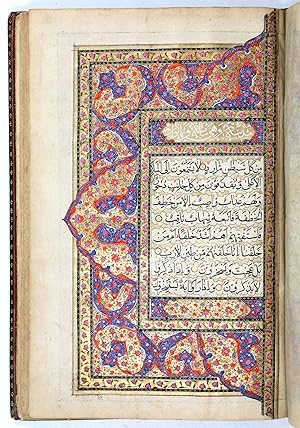
![Seller image for [ LE CORAN ou KORAN en ARABE avec TRADUCTION en LATIN ] - REFUTATIO ALCORANI , IN QUA AD MAHUMETANICAE SUPERSTITIONIS RADICEM SECURIS APPONITUR ; & MAHUMETUS IPSE GLADIO SUO JUGULATUR [ TOME II de ALORANI TEXTUS UNIVERSUS ] - 1698 - EDITION ORIGINALE for sale by LA FRANCE GALANTE](https://pictures.abebooks.com/inventory/md/md30070163547.jpg)

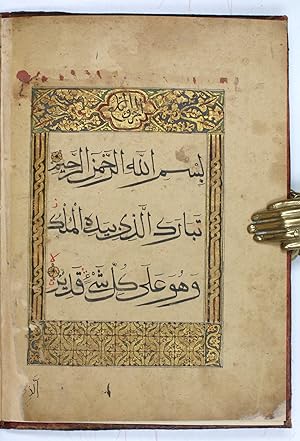
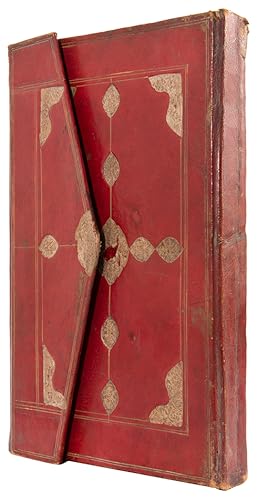

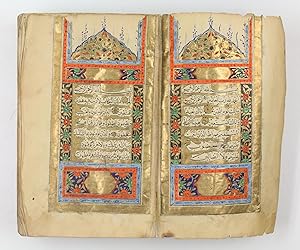
![Seller image for [The Koran.] The Alcoran of Mahomet. First English Edition. Printed in 1649. for sale by Merchants Rare Books](https://pictures.abebooks.com/inventory/md/md31527418870.jpg)
